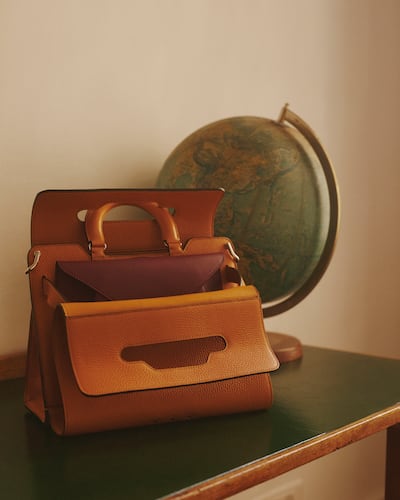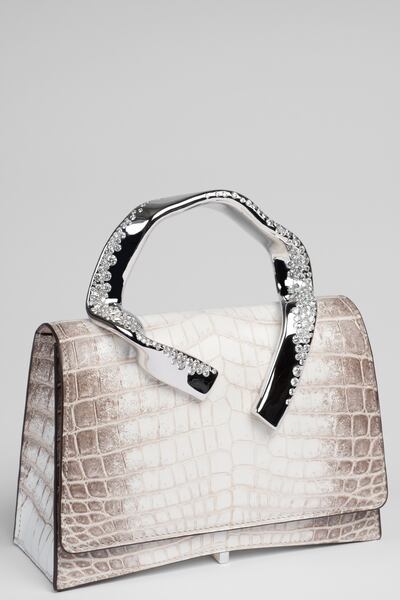"I want to make the most beautiful bags in the world,” says Sebastien Letrange at the opening of his eponymous space at Galleries Lafayette in Dubai Mall.
As a member of the seventh generation of a family once known as master leather makers – rumoured to have rivalled the likes of Hermes for prestige and quality – Sebastien has had the unique challenge of relaunching a company that initially began in 1838.
Despite having once employed 700 workers, the original Letrange quietly closed its doors in 2007, for want of family members to run it. Seven years later, in 2014, Sebastien understood the importance of what had been lost, and set about resurrecting the maison, officially reopening in 2017.
Today, the brand offers luxury leather bags built around what he describes as “heritage with a twist”. The full history may stretch for centuries, but he is quick to describe this version as “an old start-up”.
Letrange’s arrival in the Middle East is no surprise, as Sebastien spent a year here in the early 2000s, travelling through Saudi Arabia, Oman and the daunting Empty Quarter. Despite the challenges, the experience has remained with him.
“Twenty years ago, it was a different world, and although not easy, it was amazing,” he says. “I have a connection with this part of the world.”

Now, his eponymous company is crafting luxury leather bags, designed by creative director Mathias Jaquemet – who left Christian Dior for the role. Together, they are trying to rewrite the rules on what constitutes true luxury. The key, Sebastien insists, is diving into the family legacy, yet keeping the designs resolutely modern.
A prime example is the Pourquoi-Pas bag, which takes its name from the ship used by French marine scientist and explorer, Jean-Baptiste Charcot. In 1907, the original Letrange created the packing cases to transport Charcot’s fragile scientific equipment on expeditions to the North Pole. Nodding to this intrepid spirit, this new bag is remarkably versatile and can be worn in several ways, including as a top-handle bag or tote. Thanks to an unusual, but remarkably helpful open flap at the front, it can also carry a tablet, a jacket, or, like one particularly stylish Kuwaiti client, a bunch of flowers.
Another example of the duo’s avante-garde thinking is the Ego bag, which arrives at the brand’s stores either ready-made or as a finished, flat, single piece of leather. The latter version allows clients to build the bag to order and customise it. Held together by hexagonal studs – an updated version of the traditional raised nails once used to secure leather panels to carriages – which come in standard gold plate or iridium, and also with single initials, in solid gold or even with precious sapphires or rubies. Offering a new concept of personalisation, as Letrange explains, it means that this is the first bag in the world that can boast being made in Paris and assembled in Dubai or Qatar.

It was never Sebastien’s plan to resurrect the family maison, but, he concedes, perhaps it was always in his stars. Exceptionally close to his great-grandmother Henriette Letrange, who revolutionised the house when she took over after her husband’s death in the 1940s, Sebastien lived with her on and off for 20 years, absorbing her tales of adventure and travel.
Her fearlessness has clearly rubbed off, shown via a willingness to swim against the tide. A small but significant showing of this is that some Letrange bags fasten with a magnet, a detail considered verboten in the luxury industry. Yet, he did it anyway, to widespread approval from customers.
Another example is the Empreinte bag (translating to footprint in English), which is distinctive for its sinuous, curved metal handle. Aside from the feat of engineering required to attach to the leather – “It’s been a nightmare,” he quips – there is also a one-of-a-kind $1 million version of this sculptural bag, the Empreinte 178, made last year. With rare Himalayan crocodile skin used for the body, the handle is solid gold, studded with an astonishing 178 white diamonds, weighing about 33 carats. Each gem has been placed “precisely where Mathias [Jaquemet] drew them. This was made by a high jewellery atelier in Place Vendome, and just the handle is 500 hours of work,” Sebastien explains.
“For $1 million, you could have a necklace that you will wear for others, but where you will never feel the diamonds, because they are on the outside,” he explains. Traditionally, diamonds face outwards to dazzle others, yet here, are tucked away so only the holder is aware of them. “It is a sensual, private moment of absolute luxury. The gold sits lightly in the palm while the fingers rest against the faceted stones. “Diamonds are the largest concentration of energy in the world” Letrange explains of the stones he has placed – quite literally – at the fingertips of his client.
With such poetry at the heart of its bags, little wonder the company is already rumoured to have clients including Catherine Deneuve and Charlotte Casiraghi of Monaco.
Yet, each bag, he admits, has been an unending challenge to bring to life. “Everything is a nightmare, but clients don’t see that,” he laughs. Perhaps this is at the heart of the Letrange DNA, to lean into the difficulties and make the astonishingly difficult look breathlessly easy.
He describes one investor with years of experience within the luxury industry, who offered backing precisely because of Letrange’s willingness to tackle insurmountable obstacles. “He knew that what we are doing is absolutely impossible. He knew, but we didn’t,” he laughs.






